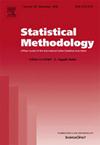使用基尼均值差异检验可变性排序
Q Mathematics
引用次数: 3
摘要
在本文中,我们基于基尼均值差异推导了一种差异度量,以检验零假设,即两个随机变量以可变型随机顺序排序,与一个严格支配另一个的替代方案具有相同的弥散性。我们描述了该测试,评估了其在各种情况下的性能,并通过使用真实数据的日志返回示例说明了该过程。本文章由计算机程序翻译,如有差异,请以英文原文为准。
Testing variability orderings by using Gini’s mean differences
In this paper, we derive a measure of discrepancy based on the Gini’s mean difference to test the null hypothesis that two random variables, which are ordered in a variability-type stochastic order, are equally dispersive versus the alternative that one strictly dominates the other. We describe the test, evaluate its performance under a variety of situations and illustrate the procedure with an example using log returns of real data.
求助全文
通过发布文献求助,成功后即可免费获取论文全文。
去求助
来源期刊

Statistical Methodology
STATISTICS & PROBABILITY-
CiteScore
0.59
自引率
0.00%
发文量
0
期刊介绍:
Statistical Methodology aims to publish articles of high quality reflecting the varied facets of contemporary statistical theory as well as of significant applications. In addition to helping to stimulate research, the journal intends to bring about interactions among statisticians and scientists in other disciplines broadly interested in statistical methodology. The journal focuses on traditional areas such as statistical inference, multivariate analysis, design of experiments, sampling theory, regression analysis, re-sampling methods, time series, nonparametric statistics, etc., and also gives special emphasis to established as well as emerging applied areas.
 求助内容:
求助内容: 应助结果提醒方式:
应助结果提醒方式:


